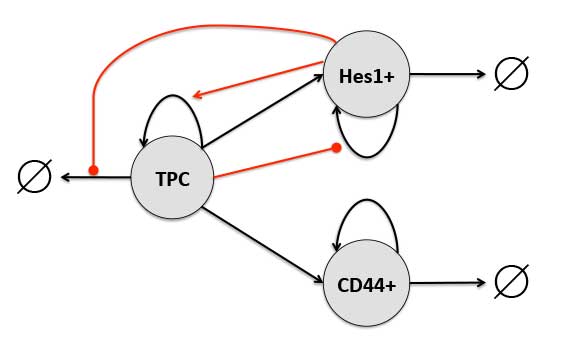Project 2: Phenotype interactions and dynamics in SCLC tumors
Leaders: Alissa M. Weaver, Julien Sage, Carlos F. Lopez
Key Personnel: Leonard A. Harris
In this project, we assess interactions of distinct SCLC cell phenotypes with each other, directed at forming an ecosystem that supports progression and treatment escape. Using a combination of mathematical modeling and experimentation, we aim to quantitatively appraise the relative role of each phenotype in driving the dynamics of tumor aggressiveness as a whole under a variety of perturbation. Cell population models will be simulated both deterministically, to predict the average behavior of a tumor, and stochastically, to evaluate the role of intrinsic and extrinsic noise. The overarching goal is to predict dependencies that are targetable, both at the molecular and cellular level, and then test these predictions in vitro and in experimental SCLC GEMMs. Tumor-propagating cells (TPCs) in SCLC GEMM tumors are neuroendocrine and strongly tumorigenic. We also characterized cell populations derived from these TPCs with distinct phenotypes, including non-neuroendocrine subpopulations that can promote the growth and the spread of neuroendocrine TPCs. With a combination of experimental and mathematical approaches we will predict key interactions between SCLC phenotypic subpopulations to uncover fragility/intervention points that could be used for treatment. We will also determine whether specific molecular cargoes carried by purified extracellular vesicles and/or secreted as soluble factors affect SCLC phenotype maintenance, growth, and survival dynamics in vitro and in vivo. The identification of secreted factors involved in SCLC communication will allow disruption of feedback loops for cell-population level mathematical model validation and eventual therapeutic intervention.
